A little downwards and sideways movement was expected, but price moved lower than expected breaching the invalidation point at the hourly chart level.
Summary: The triangle is invalidated. The bull wave count requires upwards movement tomorrow. The target for a final wave up is 2,160. A trend change to a bear market is still unconfirmed. In the first instance only a new low below 2,067.93 would increase the probability of a trend change. Thereafter, further confirmation is still required.
To see a weekly chart and how to draw trend lines go here.
Changes to last analysis are italicised.
Bull Wave Count
The bull wave count sees primary 1-2-3 within an impulse for a cycle degree wave V.
The bear wave count sees primary A-B-C zigzag for a cycle degree B wave.
The triangle is invalidated. Minuette wave (b) must have ended at the low on Thursday, or very close to it indeed, because the lower pink ii-iv trend line of the diagonal should provide strong support if this structure is incomplete. Minuette wave (c) must begin from here. At 2,160 minuette wave (c) would reach equality in length with minuette wave (a).
Downward movement for Thursday has reached a point of very strong support from the lower aqua blue line and the lower pink ii-iv diagonal trend line. It would be entirely reasonable to expect some upwards movement on Friday from this point.
The diagonal of minor wave 5 is contracting so minute wave v must be shorter than minute wave iii. Minute wave iii may not be the shortest wave. At 2,212.95 minute wave v would reach its maximum length at equality with minute wave iii.
Contracting diagonals most often end with a reasonably strong overshoot of the 1-3 trend line. The target would see this.
The diagonal trend lines are converging, and they are getting to be quite close together. This structure must end before the diagonal trend lines cross over which would be on 3rd August.
Minuette wave (b) may not move beyond the start of minuette wave (a) below 2,067.93.
The triangle was invalidated. Minuette wave (b) may have ended on Thursday as a simple zigzag.
If minuette wave (a) ends higher as labelled, then within it subminuette wave iii is 2.28 points short of equality in length with subminuette wave i, and there is no Fibonacci ratio between subminuette wave v and either of i or iii. There is perfect alternation between the deep zigzag of subminuette wave ii and the shallow contracting triangle of subminuette wave iv.
Minuette wave (b) may have been a simple zigzag. Subminuette wave a was an impulse and subminuette wave c an ending expanding diagonal. Subminuette wave c is 2.55 points short of equality in length with subminuette wave a.
Because price is now touching the lower pink ii-iv diagonal trend line, this is where downwards movement would be extremely likely to end for this bullish wave count. If downwards movement continues tomorrow, and this trend line is breached by one or more full hourly candlesticks fully below the line and not touching it, then the probability of this main bull wave count will reduce and the probability of the alternate below will increase.
Only a new low below 2,067.93 would fully invalidate this main bull wave count at this stage.
Minuette wave (a) lasted 10 days and minuette wave (b) also lasted 10 days. Minuette wave (c) may last either 10 days as well, or maybe it will last 14 days so that minute wave v totals a Fibonacci 34 days.
Alternate Bull Wave Count
It is possible that the S&P has seen a primary degree (or for the bear count below a cycle degree) trend change ten days ago.
This wave count absolutely requires confirmation at the daily chart level before any confidence may be had in a primary (or cycle) degree trend change. Confirmation would come with:
1. A close of 3% or more of market value below the lower aqua blue trend line.
2. A clear five down on the daily chart.
3. A new low below 1,820.66.
As each condition is met the probability of a substantial trend change would increase.
Primary wave 4 would most likely be a time consuming flat, triangle or combination in order to exhibit structural alternation with the zigzag of primary wave 2. Primary wave 2 lasted 12 weeks. Primary wave 4 is likely to be longer in duration because combinations and triangles particularly are more time consuming than zigzags which tend to be quick corrections. Primary wave 4 may be expected to last more than 12 weeks, and may end with a total Fibonacci 13 or more likely 21 weeks.
For this more bearish wave count to be taken seriously it still requires confirmation at least below 2,067.93.
Just in case price continues to drop (as ADX indicates it may), it is time to provide an hourly chart for this wave count.
If there has been an end to primary wave 3 eleven days ago, then the new bear market still does not have a clear five down on the hourly chart, let alone on the daily. Both of these are required for confidence in a trend change of this magnitude.
So far to the downside there may be a series of three overlapping first and second waves. The middle of the third wave must increase momentum beyond that seen for the first wave down, but has not done so yet.
At 2,069 minute wave iii would reach 1.618 the length of minute wave i. If this target is wrong it may be too high. At 2,113 minute wave iii would reach 2.618 the length of minute wave i.
Within the middle of the third wave, micro wave 4 may not move into micro wave 1 price territory above 2,110.80. If price invalidates this alternate wave count tomorrow, I will have more confidence in the main wave count.
The pink channel is a best fit channel. Downwards movement for the middle of a third wave should be strong enough to break below support at the lower pink trend line.
Bear Wave Count
The subdivisions within primary waves A-B-C are seen in absolutely exactly the same way as primary waves 1-2-3 for the bull wave count.
To see the difference at the monthly chart level between the bull and bear ideas look at the last historical analysis here.
At cycle degree wave b is over the maximum common length of 138% the length of cycle wave a, at 170% the length of cycle wave a. At 2,393 cycle wave b would be twice the length of cycle wave a and at that point this bear wave count should be discarded.
While we have no confirmation of this wave count we should assume the trend remains the same, upwards. This wave count requires confirmation before I have confidence in it. Full and final confirmation that the market is crashing would only come with a new low below 1,370.58. However, structure and momentum should tell us long before that point which wave count is correct, bull or bear.
On Balance Volume has very slightly breached a trend line which began back in October 2014. This may be an early warning of more downwards movement to come.
Technical Analysis
ADX is rising and above 15. This indicates the potential start of a new trend. The direction would be down.
While price remains above the lower aqua blue trend line a bull market should be assumed to remain intact. Only when this lower aqua blue trend line is breached by a close of 3% or more of market value would a bear market be indicated. That trend line is long held (it began in November 2011), repeatedly tested and reasonably shallow so it is highly technically significant. It should be respected. It is the strongest piece of technical analysis on this chart.
On Balance Volume is showing negative divergence with price. The recent rise in price to new all time highs is not supported by volume and so is suspicious. This may indicate that when the bear market arrives it may be deeper and more long lasting than recent corrections.
If data for Thursday’s session for ADX brings the ADX line to 20 or above the bearish scenario would be supported.
The shorter EMA needs to cross below the longer EMA to provide further confidence in a bear market.
This analysis is published about 08:04 p.m. EST.

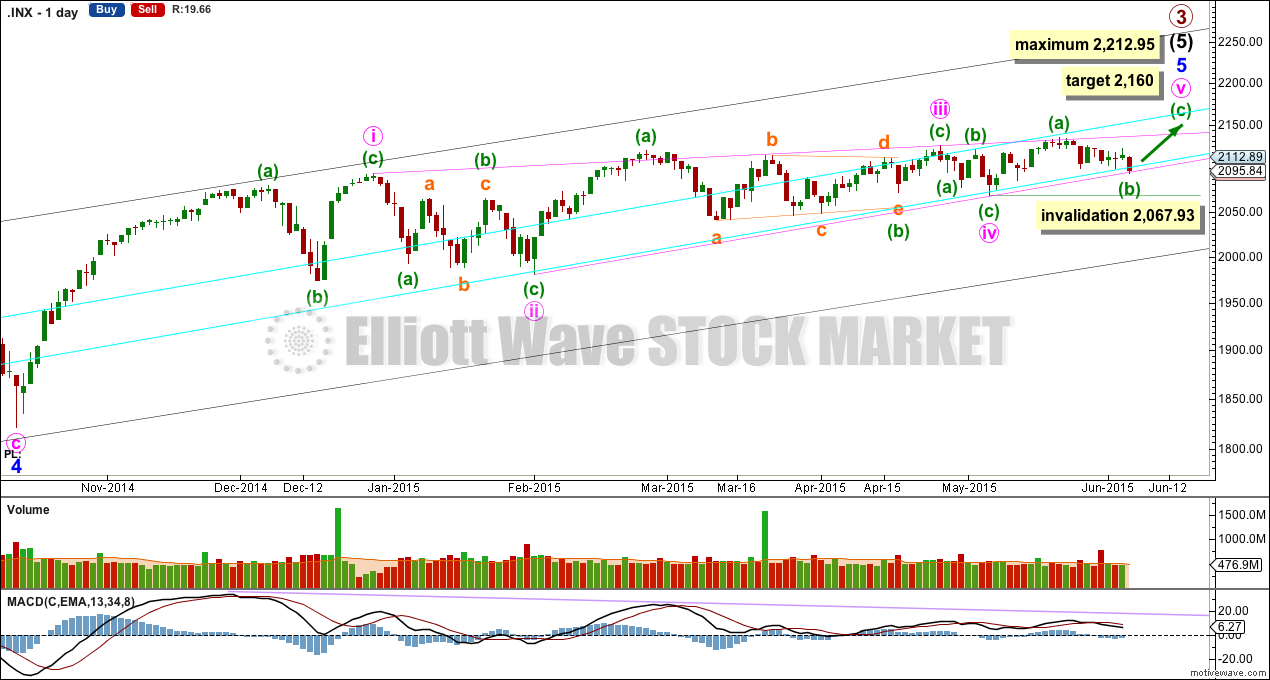
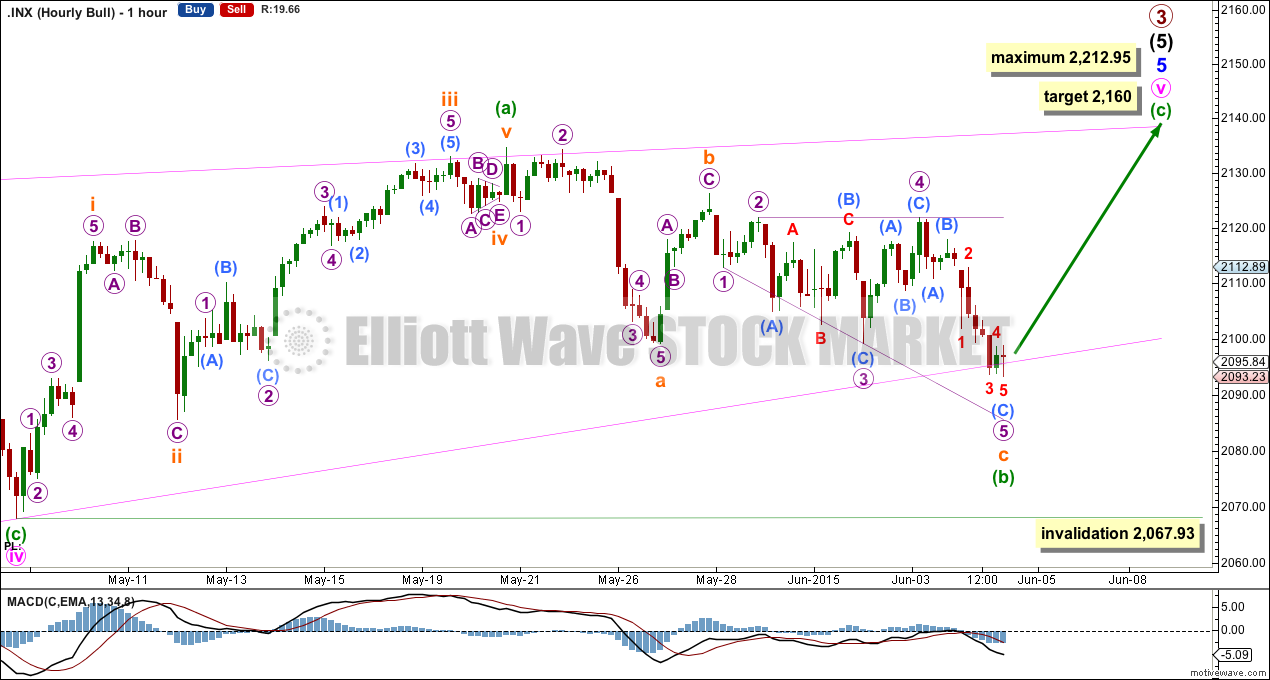
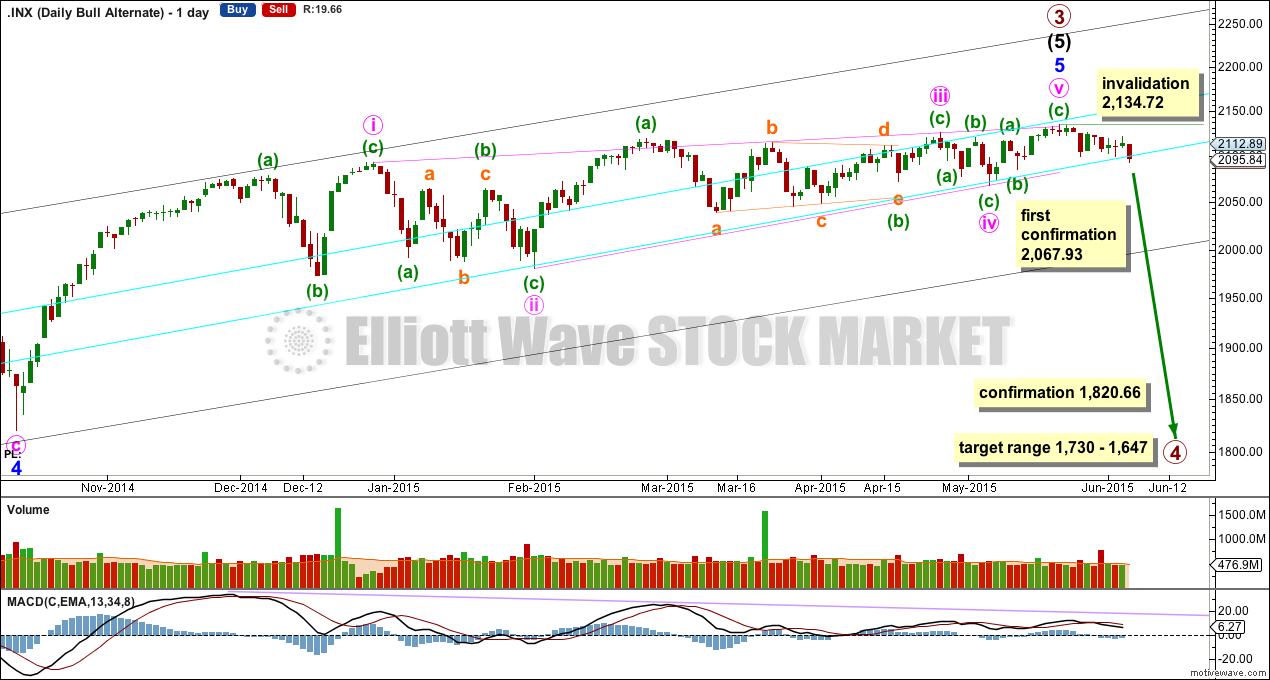
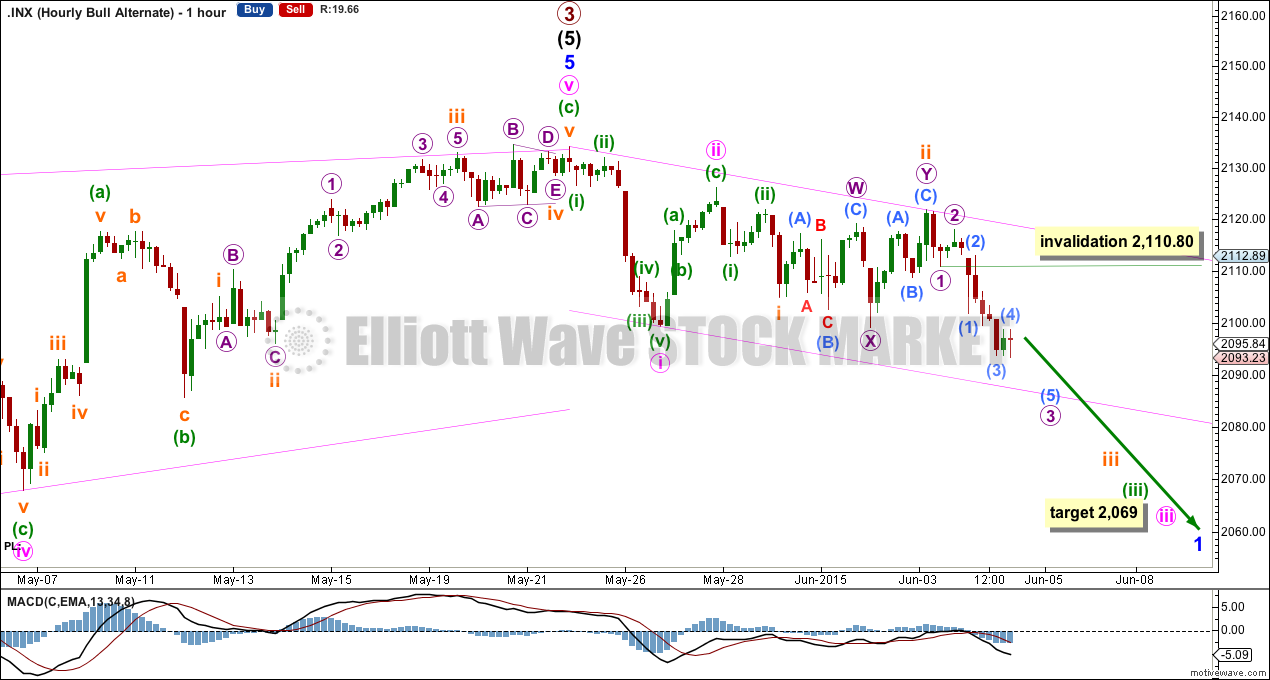
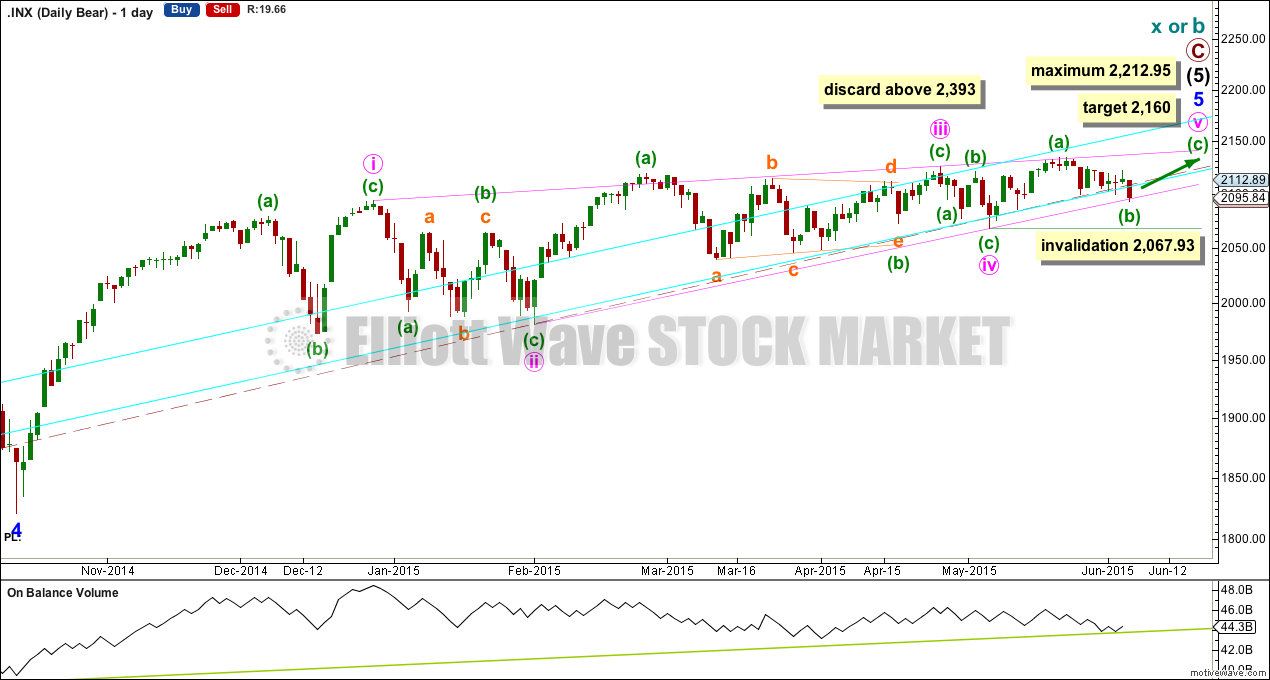
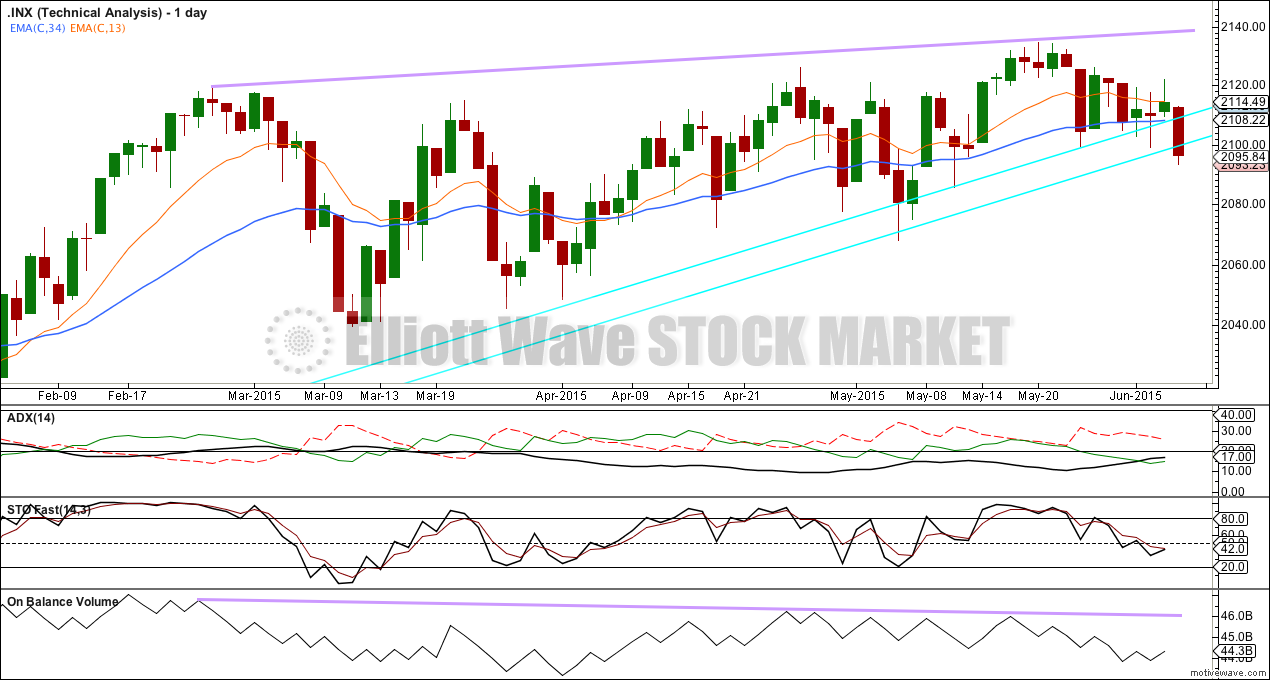
Strange! 2 – 4 diagonal trendlines in both DOW and SPY clearly breached but no downside momentum normally associated with reversal for ending contracting diagonal. Something’s gotta give…
And it looks like for Monday that it’s giving! I’ll still assume the trend remains the same until proven otherwise though. If this is a bear market we’re still in the very early stages and we still don’t have confirmation… yet.